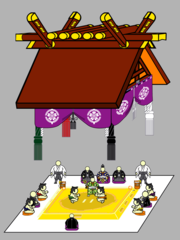
Dohyo
Encyclopedia

Sumo
is a competitive full-contact sport where a wrestler attempts to force another wrestler out of a circular ring or to touch the ground with anything other than the soles of the feet. The sport originated in Japan, the only country where it is practiced professionally...
wrestling bouts are held. A modern dohyo is a circle of rice-straw bales 4.55 meters in diameter, mounted on a square platform of clay
Clay
Clay is a general term including many combinations of one or more clay minerals with traces of metal oxides and organic matter. Geologic clay deposits are mostly composed of phyllosilicate minerals containing variable amounts of water trapped in the mineral structure.- Formation :Clay minerals...
6.7m on a side, and 34 to 60 cm high. The surface is covered by sand
Sand
Sand is a naturally occurring granular material composed of finely divided rock and mineral particles.The composition of sand is highly variable, depending on the local rock sources and conditions, but the most common constituent of sand in inland continental settings and non-tropical coastal...
.
A new dohyō is built prior to each tournament by the yobidashi
Yobidashi
The yobidashi calls a professional sumo wrestler, or rikishi, to the dohyō immediately prior to his bout...
, who are responsible for this activity. The dohyō is removed after each tournament, and in the case of Nagoya, pieces are taken home by the fans as souvenirs. The yobidashi also build the dohyō for training stables and sumo touring events.
The diameter of the ring is 15 shaku (4.55 meters), which increased from 13 shaku (3.94 meters) in 1931. The rice-straw bales (tawara (俵)) which form the ring are one third standard size and are partially buried in the clay of the dohyō. Four of the tawara are placed slightly outside the line of the circle. In olden times this was to allow rain to run off the surface, when sumo tournaments were held outdoors in the open. Today a wrestler under pressure at the edge of the ring will often try to move himself round to one of these points to gain leverage in order to push back more effectively against the opponent who is trying to force him out.
At the center are two white lines, the shikiri-sen (仕切り線), behind which the wrestlers must position themselves at the start of the bout. Around the ring is finely brushed sand called the ja-no-me (蛇の目 snake's eye), which can be used to determine if a wrestler has just touched his foot, or another part of his body, outside the ring. The yobidashi ensure it is clean of any previous marks immediately prior to each bout.
A roof resembling that of a Shinto shrine is suspended above the dohyō. Colored tassels (fusa) are suspended from the corners, representing the four spirits
Four Symbols (Chinese constellation)
The Four Symbols are four mythological creatures in the Chinese constellations. They are:*Azure Dragon of the East *Vermilion Bird of the South *White Tiger of the West *Black Tortoise of the North...
of directions:
- Azure Dragon of the East (青龍)
- Vermilion Bird of the South (朱雀)
- White Tiger of the WestWhite Tiger (Chinese constellation)The White Tiger is one of the Four Symbols of the Chinese constellations. It is sometimes called the White Tiger of the West , and is known as Baihu in Chinese, Byakko in Japanese, Baekho in Korean and Bạch Hổ in Vietnamese...
(白虎) - Black Tortoise of the North (玄武)

